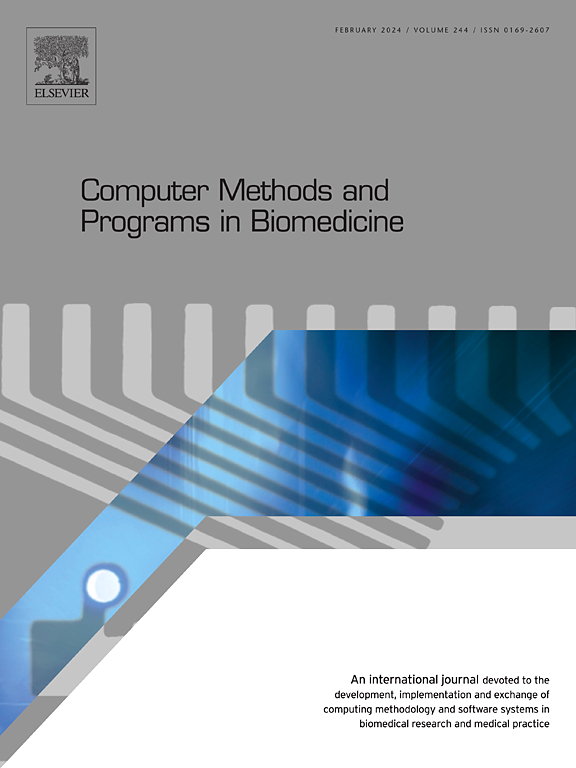SIAM: Spatial and Intensity Awareness Module for cerebrovascular segmentation
IF 4.9
2区 医学
Q1 COMPUTER SCIENCE, INTERDISCIPLINARY APPLICATIONS
引用次数: 0
Abstract
Background and objectives:
Cerebrovascular segmentation plays a crucial role in guiding the diagnosis and treatment of cerebrovascular diseases. With the rapid advancements in deep learning models, significant progress has been made in 3D cerebrovascular segmentation. However, they often rely on massive images and annotations, which is still challenging in cerebrovascular segmentation.
Methods:
Considering the unique pixel and spatial features inherent to vascular structures, such as vessel shape, location, and high pixel intensity characteristics, we propose a novel Spatial and Intensity Awareness Module (SIAM) for limited cerebrovascular segmentation. This module introduces spatial and pixel intensity perturbations to construct new matching data for model learning. Using collaborative training and shared features, SIAM gains the awareness of spatial and pixel intensity, thereby endowing the model with cerebrovascular semantics. Owing to the awareness learning belonging to an independent training module, SIAM satisfies the attribute of plug-and-play.
Results:
To validate SIAM, we carried out experiments on three cerebrovascular datasets with different modalities. The results demonstrate that SIAM enables the models to perform remarkably in normal and limited cerebrovascular segmentation. It can be seamlessly integrated into existing segmentation models without disrupting structural integrity.
Conclusion:
SIAM effectively learns and adapts to the unique spatial and pixel intensity features of vascular structures through collaborative training and shared features. Our experiments on three different cerebrovascular datasets confirm its robustness and efficacy even with limited data. Furthermore, its plug-and-play nature allows for seamless integration into existing models, preserving their structural integrity. Our code is available at https://github.com/QingYunA/SIAM-Spatial-and-Intensity-Awareness-Module-for-3D-Cerebrovascular-Segmentation.
SIAM:用于脑血管分割的空间和强度感知模块
背景与目的:脑血管分割在指导脑血管疾病的诊断和治疗中起着至关重要的作用。随着深度学习模型的快速发展,在脑血管三维分割方面取得了重大进展。然而,它们往往依赖于大量的图像和注释,这在脑血管分割中仍然是一个挑战。方法:考虑到血管结构固有的独特像素和空间特征,如血管形状、位置和高像素强度特征,我们提出了一种新的空间和强度感知模块(SIAM)用于有限脑血管分割。该模块引入空间和像素强度扰动来构建新的匹配数据用于模型学习。SIAM通过协同训练和共享特征,获得空间和像素强度的感知,从而赋予模型脑血管语义。由于意识学习属于独立的训练模块,SIAM满足即插即用的属性。结果:为了验证SIAM,我们在三个不同模式的脑血管数据集上进行了实验。结果表明,SIAM使模型在正常和受限的脑血管分割中表现良好。它可以无缝集成到现有的分割模型中,而不会破坏结构的完整性。结论:SIAM通过协同训练和共享特征,有效地学习和适应血管结构独特的空间和像素强度特征。我们在三个不同的脑血管数据集上的实验证实了它的鲁棒性和有效性,即使数据有限。此外,它的即插即用特性允许无缝集成到现有模型中,保持其结构完整性。我们的代码可在https://github.com/QingYunA/SIAM-Spatial-and-Intensity-Awareness-Module-for-3D-Cerebrovascular-Segmentation上获得。
本文章由计算机程序翻译,如有差异,请以英文原文为准。
求助全文
约1分钟内获得全文
求助全文
来源期刊

Computer methods and programs in biomedicine
工程技术-工程:生物医学
CiteScore
12.30
自引率
6.60%
发文量
601
审稿时长
135 days
期刊介绍:
To encourage the development of formal computing methods, and their application in biomedical research and medical practice, by illustration of fundamental principles in biomedical informatics research; to stimulate basic research into application software design; to report the state of research of biomedical information processing projects; to report new computer methodologies applied in biomedical areas; the eventual distribution of demonstrable software to avoid duplication of effort; to provide a forum for discussion and improvement of existing software; to optimize contact between national organizations and regional user groups by promoting an international exchange of information on formal methods, standards and software in biomedicine.
Computer Methods and Programs in Biomedicine covers computing methodology and software systems derived from computing science for implementation in all aspects of biomedical research and medical practice. It is designed to serve: biochemists; biologists; geneticists; immunologists; neuroscientists; pharmacologists; toxicologists; clinicians; epidemiologists; psychiatrists; psychologists; cardiologists; chemists; (radio)physicists; computer scientists; programmers and systems analysts; biomedical, clinical, electrical and other engineers; teachers of medical informatics and users of educational software.
 求助内容:
求助内容: 应助结果提醒方式:
应助结果提醒方式:


